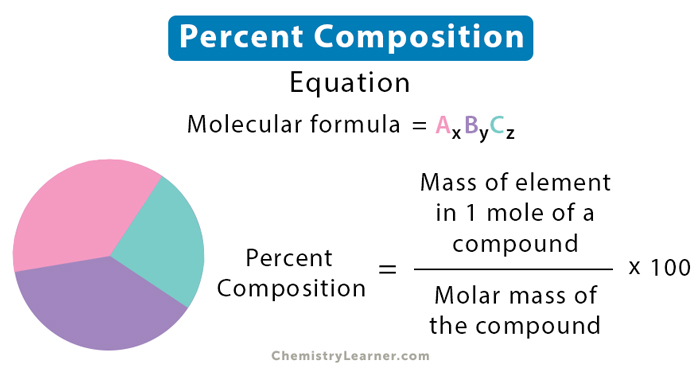Percent Composition
A chemical compound consists of two or more elements. The percent composition tells us what percent of an element is present by mass in a compound. Its value is given as a percent. Percent composition helps estimate the relative abundance of a specific element in different compounds of known formulas [1-4].
Percent composition is an extensive property. It means that it is independent of size. For instance, if you have a bucket of sand or a spoonful, the percent composition will always be the same.
Percent Composition Formula
The following equation gives the percent composition by mass [2].
Percent composition = (mass of the element in 1 mole of the compound) / (molar mass of the compound) x 100%
The masses are expressed in grams. Therefore, percent composition is often called percent mass.
How to Find Percent Composition
To determine the percent composition, let us take the example of water. Water has the formula H2O. It has two hydrogen (H) atoms and one oxygen (O) atom. Below are the steps to find the percent composition of all the elements in a compound [1].
Step 1: Find the molar mass of all elements in the compound in terms of grams per mole (g mol-1).
For H2O, the molar masses are as follows:
H: 1 g
O: 16 g
Step 2: Find the molar mass of the entire compound.
Molar mass of H2O = 2 x 1 g + 16 g = 18 g
Step 3: Divide the element’s mass by the compound’s molar mass.
H: (2 x 1 g)/18 g = 0.111
O: 16 g/18 g = 0.889
Step 4: Multiply the results from Step 3 by 100 to obtain the percent mass.
H: 0.111 x 100 = 11.1%
O: 0.889 x 100 = 88.9%
Note
- The sum of the percent compositions of each element adds up to 100.
- In the case of binary compounds, it is possible to calculate the percent composition of the second element by subtracting the percent composition of the first element from 100.
How to Determine Empirical Formula from Percent Composition
The empirical formula of a compound is the most straightforward formula that gives the proportion of elements comprising the compound. In other words, it is the simplest whole-number ratio of each element in the compound. It can be determined using the percent composition of the individual elements. Here are the steps.
Step 1: Express the percent composition of each element in grams by assuming that the mass of the compound is 100 g.
Step 2. Convert the mass of each element into moles.
Step 3. Divide each value obtained in step 2 by the smallest of all values.
Step 4. If any result from step 3 comes out as a fraction, multiply it by an integer to convert the fractional value into a whole number.
Example Problem
An acid commonly used in the automotive industry is shown to be 31.6% phosphorous, 3.1% hydrogen, and 65.3% oxygen. Determine the empirical formula of this acid.
Solution
Step 1
P: 31.6 g
H: 3.1 g
O: 65.3 g
Step 2
P: 31.6 g / 30.97 g mol-1 = 1.02 mol
H: 3.1 g / 1.00 g mol-1 = 3.1 mol
O: 65.3 g / 16.00 g mol-1 = 4.08 mol
Step 3
P: 1.02 mol/1.02 mol = 1
H: 3.1 mol/1.02 mol = 3
O: 4.08 mol/1.02 mol = 4
The empirical formula is H3PO4.
Applications of Percent Composition in Daily Life [1]
Chemists use percent composition to determine the composition of unknown substances. It is also used in the food and beverage industry to determine nutritional facts. One can find them on the label.
For instance, peanut butter contains protein, sodium, carbohydrate, and fat. Sugar falls under carbohydrates. Suppose one serving of peanut butter contains 3 grams of sugar, and each serving is 32 grams. Then, the percent composition of sugar in peanut butter is 9.38%.
Example Problems
Problem 1: Find the percent composition of all the elements in one mole of carbon dioxide (CO2).
Solution
The molar masses of carbon and oxygen are:
C: 12 g
O: 16 g
Molar mass of CO2 is = 12 g x 2 x 16 g = 44 g
The percent compositions are as follows:
C: 12 g / 44 g x 100 = 27.3%
O: (2 x 16 g)/44 g x 100 = 72.7%
Problem 2: What is the percent composition of KMnO4?
Solution
The following table gives the percent composition of the individual elements in KMnO4.
| Element | Molar mass (g) | Number of times the element appears in the compound | Mass of the element in the compound (g) | Percent composition |
|---|---|---|---|---|
| K | 39.10 | 1 | 39.10 | (39.10/158.04) x 100 = 24.74% |
| Mn | 54.94 | 1 | 54.94 | (54.94/158.04) x 100 = 34.76% |
| O | 16.00 | 4 | 64.00 | (64.00/158.04) x 100 = 40.5% |
| Total | 158.04 | 100 |
Problem 3: A 100 gram of a particular compound is 80.0% carbon (C) and 20% hydrogen (H) by mass. Use this information to find out the compound’s empirical formula.
Solution
Step 1
C: 80 g
H: 20 g
Step 2
C: 80 g/12 g = 6.67 mol
H: 20 g/1 g = 20 mol
Step 3
C: 6.67 mol/ 6.67 mol = 1
H: 20 mol/ 6.67 mol = 3
The empirical formula is CH3.




